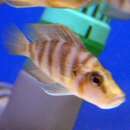en
names in breadcrumbs


Altolamprologus compressiceps is a species of fish in the family Cichlidae. It is endemic to the shallow rocky areas of Lake Tanganyika. It is not considered threatened by the IUCN.[1]
It is physically similar to its close relative A. calvus, though it is deeper-bodied and has a shorter snout.
Several local variants exist, and some may prove to be distinct species or subspecies. Some examples include:
Lake Tanganyika holds at least 250 species of cichlid fish[3] and there are still undescribed species in the lake.[4] Almost all (98%) of the Tanganyika cichlids are endemic to the lake and it is thus an important biological resource for the study of speciation in evolution.[5][6]
Altolamprologus compressiceps is a species of fish in the family Cichlidae. It is endemic to the shallow rocky areas of Lake Tanganyika. It is not considered threatened by the IUCN.